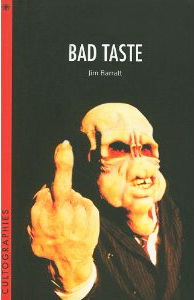BOOK
REVIEW:
BAD TASTE by Jim Barratt
Wallflower
Press
(London, UK
– distributed in the US through Columbia University Press)
2008
106pp
The guys of the 'Cultographies' series
are back at it again, with some new titles! We've already presented their first
three books on this site: THE ROCKY HORROR PICTURE SHOW, DONNIE DARKO and THIS
IS SPINAL TAP. You'll remember them as the slightly more accessible variety of
what BFI is doing in their 'classics' series: small, serious but readable accounts
of the production, evaluation and influence of some major modern titles – in
this case, devoted entirely to ''the weird and wonderful world of cult
cinema''. The series editors, Ernest Mathijs and Jamie Sexton, now proudly
present Jim Barratt's analysis of Peter Jackson's cult classic, BAD TASTE.
In
its form, the book stays close to that envisioned for the whole series: it
opens with a personal note (how the author came across the film, what it meant for
him back then, what it means for him now), continues with behind-the-scenes
facts of the painful birth process (always a fun read when it comes to the
usual guerilla filmmaking in the low budget arena!), culminating, of course,
with the analysis (what, exactly, makes the particular title the object of a
cult following? what does it all mean? what's the significance? etc.) and
further relevance for the genre it belongs to and to (cult) cinema in general.
The
author, Jim Barratt, is a fine choice for this book: as a former Film and Video
Examiner for the British Board of Film Classification he can provide some rare facts
about the various censorship issues that BAD TASTE sometimes encountered, and
how, eventually, it was cleared of that danger in most countries, passing uncut
in spite of its copious amounts of splattering gore, vomit, goo and the like.
Obviously, BAD TASTE was one of those rare instances in which someone actually
paid attention to the context of its set-pieces, and the context justified the
exception.
Even the censors were able to recognize that all of the 'bad taste'
on display, including exaggerated dismemberments, geysers of blood etc. were
used for obvious humorous purpose, in a context that's more infantile than
'nasty'. Barratt also rightly points to the similarities between Jackson's
peculiar 'splatstick' (splatter + slapstick) and Monty Python's memorable uses
of similarly extreme and intentionally goofy effects, like in the famous gore-galore
sketch of "Sam Peckinpah's SALAD DAYS" or in the unforgettable episode
from MONTY PYTHON'S THE MEANING OF LIFE with the gluttonous, obese man who gorges
himself (and vomits every once in a while) until he explodes all over the fancy
restaurant.
Because
of its comedic elements, together with bits and pieces of other genres (Sci-Fi,
action, etc.), Barratt claims that BAD TASTE is not really a horror film at
all: other than the splatter effects (used for comedic effect), there is no
evidence of suspense, fear, creepiness or anything remotely scary (unlike, say,
some other splatter-horror comedies, like THE EVIL DEAD or RE-ANIMATOR). Thanks
to its light-hearted tone BAD TASTE could expect a better understanding among
the frowning censors around the world, and it is certainly one of the keys of
its general appeal. Nothing is really dark or edgy about it: it's a series of
juvenile 'sick', but essentially inoffensive jokes in which no one (and nothing
of value) is really hurt. There is no deeper point, no relevance, no
subversiveness to speak of, except the most basic puerile provocation of
lavatory humor and childish 'bad taste'.
It's
an exercise in style by a budding filmmaker trying to draw attention to himself
by a calculated effort to make a CULT film. There is plenty of evidence in the
book that Jackson knew what he was doing, right from the start (see the excerpt
from the letter in which he asked for financing from the officials). "BAD
TASTE was actively marketed and distributed in ways designed to solicit cult
status", says Barratt (page 52). But, significantly, he adds: "But
for the film to be adopted as such by
its audience, it has to offer them something different, some special qualities
worthy of their devotion." Jackson did offer something new and,
eventually, rightly got where he is now.
The
first three films analyzed in the 'Cultographies' series all dealt with some
significant issues: gender roles in ROCKY HORROR; time, death and sacrifice in
DONNY; rock culture and documentary genre in SPINAL TAP. Unlike them, BAD TASTE
is not really about anything, and that may be the reason why this volume is
some 20 pages slimmer than the previous entries. Although short, this book is
by no means lightweight, and serious tools are used to analyze what little
there was to be analyzed.
It also provides numerous amusing anecdotes and facts
about the film (especially the local, New Zealand specific references lost on
many international viewers), but one feels much more of the similar material
could've been used to make the text somewhat weightier. At least, the book
points to numerous sources (articles, books, even web sites) which might be
valuable to those cultists willing to explore more background of one of the
most inauspicious debuts in the history of cinema. From rags (BAD TASTE) to
riches (LORD OF THE RINGS trilogy, Oscars etc.).
The other new 'Cultographies' titles
are devoted to Orson Welles's TOUCH OF EVIL and SUPERSTAR: THE KAREN CARPENTER
STORY. On the other hand, those interested in BAD TASTE's older (and better) splatstick
brother can eagerly anticipate the announced EVIL DEAD volume. Stay tuned!
Originally
published at Beyondhollywood












Нема коментара:
Постави коментар